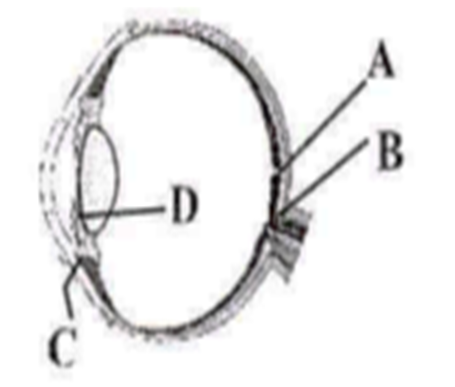 Multiple Choice Questions
Multiple Choice QuestionsWhich of the following is true for the function disease in family A and B? of labelled parts in the diagram below?

A - Blind spot - Image is formed here
B - Fovea - No visual activity is present
C - Cornea - Helps to hold lens in place
D - Iris - Visible coloured portion of eye
Assertion : Corpus callosum connects the two cerebral hemispheres.
Reason : Association areas are responsible for complex functions like intersensory association of memory and communication.
If both assertion and reason are true and reason is the correct explanation of assertion.
If both assertion and reason are hue but reason is not the correct explanation of assertion.
If assertion is true but reason is false.
If both assertion and reason are false.
Assertion : Auditory ossicles are small bones present in the cavity of inner ear.
Reason : Auditory ossicles maintain the balance of air pressure between two sides of ear drum.
If both assertion and reason are true and reason is the correct explanation of assertion.
If both assertion and reason are true but reason is not the correct explanation of assertion.
If assertion is true but reason is false
If both assertion and reason are false.
Which of the following nerves arises from organ of Corti?
Olfactory nerve
Cochlear nerve
Abducens nerve
None of these
Assertion: Organ of Corti rests on tectorial membrane.
Reason: It helps to maintain equilibrium of body
If both assertion and reason are true and reason is the correct explanation of assertion
If both assertion and reason are true but reason is not the correct explanation of assertion
If assertion is true but reason is false
If both assertion and reason are false.
Assertion : Connective tissue inside the brain is essential for conduction of nerve impulse.
Reason : Connective tissue hold together the nerve cells of brain.
If both assertion and reason are true and reason is the correct explanation of assertion
If both assertion and reason are true but reason is not the correct explanation of assertion
If assertion is true but reason is false
If both assertion and reason are false
One common example of simple reflex is
tying your shoe laces while talking to another person and not looking at them
watering of mouth at the sight of a favourite food
climbing up a stairs in dark without stumbling
closing of eyes when strong light is flashed across them.
D.
closing of eyes when strong light is flashed across them.
Simple or unconditional reflexes are present in an individual right from birth. They are specific, predictable, purposeful and have survival value, e.g. breast feeding and swallowing in newly born babies and blinking of eyes are examples of unconditioned reflexes.
(a), (b) and (c) are the examples of conditional reflexes and are not present at birth but develop later in life through learning habit.
Injury to vagus nerve in humans is not likely to affect
tongue movements
gastrointestinal movements
pancreatic secretion
cardiac movements.
Which match is true?
| Vitamin deficiency disease | Vitamin | Source |
| Severe bleeding | Tocopherol | Milk, egg |
| Anaemia | Ascorbic acid | Lemon, orange |
| Night blindness | Retinol | Carrot, milk |
| Sterility | Calciferol | Milk, butter |
